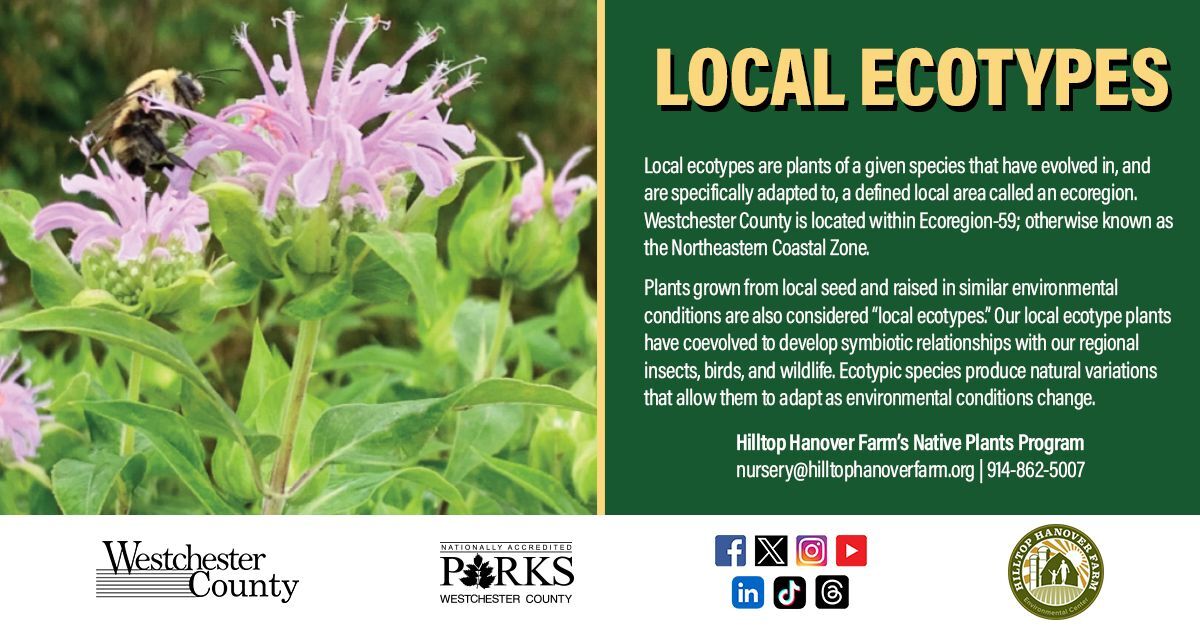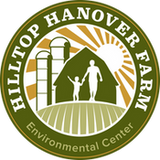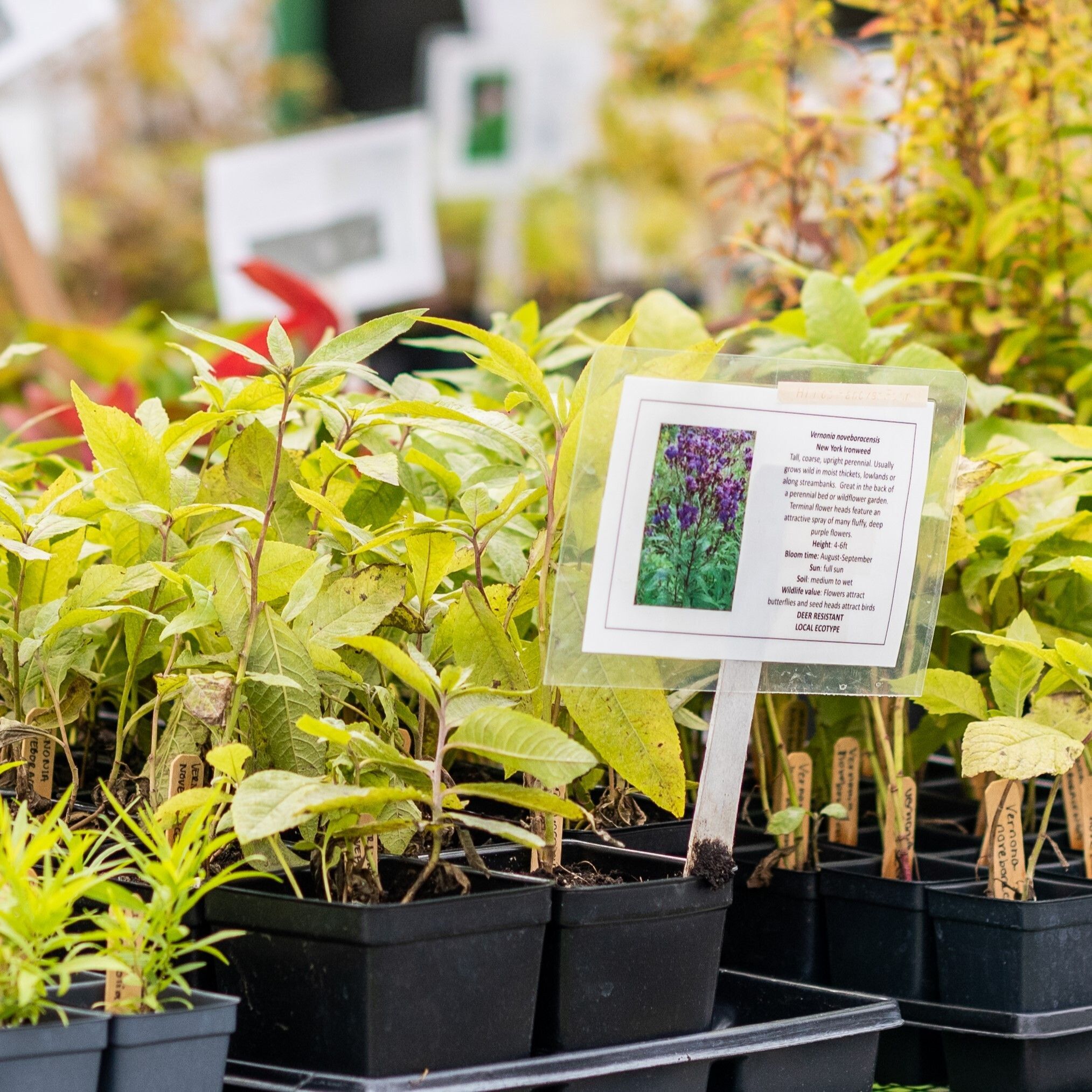Native Plants are sold through our Farm Stand.
We have adjusted our native plant growing schedule to more closely align with our species’ natural seasonal patterns. This will help lower plant stress, resulting in healthier and more resilient seedlings. Additional species will be available in the fall.
Some species now available in quart size. Inventory quantities are subject to change daily. For specific inventory questions, please call our Farm Stand, (914) 862-5034, or email Emily Rauch, nursery@hilltophanoverfarm.org.
-
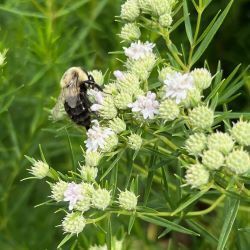 Narrowleaf Mountain Mint
Narrowleaf Mountain MintPycnanthemum tenuifolium
This vigorous mountain mint forms colonies and has clusters of showy white flowers. It has very narrow, needle like leaves that smell strongly of mint when crushed.
Height: 2-3ft
Bloom time: July-September
Sun: full sun to part shade
Soil: medium to dry
Wildlife value: attractive to many kinds of butterflies, bees, wasps, flies and beetlesDEER RESISTANT
LOCAL ECOTYPE*Original ecotype collected in Newtown, CT; seed grown out at Hilltop Hanover Farm.
_____ -
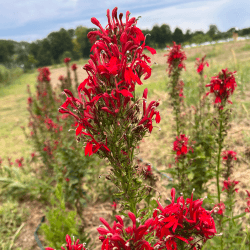 Cardinal Flower
Cardinal FlowerLobelia cardinalis
Stunning wetland plant with erect, terminal spikes of bright scarlet red tubular flowers.
Height: 2-4ft
Bloom time: July-September
Sun: full sun to part shade
Soil: wet to medium wet
Wildlife value: important nectar source for hummingbirds and swallowtail butterfliesDEER RESISTANT
LOCAL ECOTYPE*Original ecotype collected in Redding, CT; seed grown out at Hilltop Hanover Farm.
_____ -
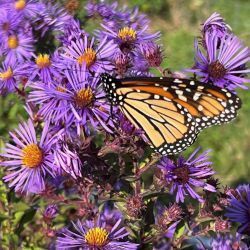 New England Aster
New England AsterSymphyotrichum novae-angliae
This large, showy aster is an important source of pollen and nectar long after summer blooming flowers have faded. Clusters of composite flowers consist of yellow disk florets surrounded by numerous lavender/purple ray florets. A great plant for a wildflower border, moist meadow or open area.
Height: 3-6 ft
Bloom Time: August- October
Sun: full sun to part shade
Soil: medium to moist
Wildlife value: visited by various bees, butterflies and skippers, larval food to many moths and butterfliesLOCAL ECOTYPE
*Original ecotype collected in Brookfield, CT; seed grown out at Hilltop Hanover Farm.
_____ -
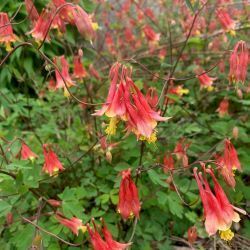 Eastern Red Columbine
Eastern Red ColumbineAquilegia canadensis
Woodland wildflower with showy red, drooping, bell shaped flowers. One of the first to provide nectar in the spring and flowering coincides with the return of migrating hummingbirds! Tolerates a wide range of soil and light conditions. Delicate foliage remains attractive throughout the growing season.
Height: 2ft
Bloom time: April-May
Sun: full sun to part shade
Soil: moist to dry
Wildlife value: Attracts hummingbirds, bees and butterflies, larval host plant to the Columbine Duskywing Butterfly and the Columbine Borer MothGood deer resistance
LOCAL ECOTYPE*Original ecotype collected in Dutchess/Columbia County, NY; seed grown out at Hilltop Hanover Farm.
_____ -
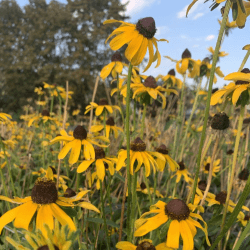 Black-Eyed Susan
Black-Eyed SusanRudbeckia hirta
This long blooming wildflower is a biennial or short-lived perennial. It freely self-seeds to persist for many years in the garden. Bright yellow daisy like flowers attract many pollinators.
Height: 2-3ft
Bloom time: June-October
Sun: Full sun
Soil: medium to dry
Wildlife value: A great source of pollen and nectar for bees, as well as butterflies, flies and beetles. A larval host plant for the Silvery Checkerspot ButterflyDEER RESISTANT
LOCAL ECOTYPE*Original ecotype collected in Newtown, CT; seed grown out at Hilltop Hanover Farm.
_____ -
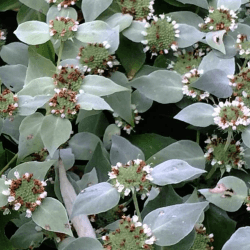 Short Toothed Mountain Mint
Short Toothed Mountain MintPycnanthemum muticum
A pollinator and insect magnet! This fast spreading, aromatic perennial smells strongly of mint, making it highly deer resistant. The flowers are subtle, but the leaves have a distinct silver color that give a nice glow when planted grouped together. It spreads by rhizomes and is great for naturalization.
Height: 1-3ft.
Bloom time: July-September
Sun: full to part sun
Soil: medium to dry
Wildlife value: attractive to many kinds of butterflies, bees, wasps, flies and beetlesDEER RESISTANT
LOCAL ECOTYPE*Original ecotype collected in Bethel, CT; seed grown out at Hilltop Hanover Farm.
_____ -
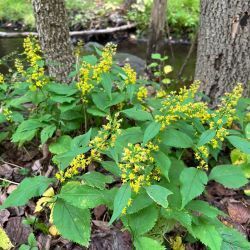 Blue Stem Goldenrod
Blue Stem GoldenrodSolidago caesia
This shade-tolerant goldenrod bears yellow flower clusters in the axils along it's purple/bluish stems. The branching, arching stems give this plant a graceful appearance. This goldenrod behaves in the garden and is not aggressive.
Height: 3ft
Bloom time: August - October
Sun: Medium- partial shade
Soil: Medium -medium dry
Wildlife value: the pollen and nectar attract a wide variety of insects, it is a larval host plant to beetles, a leafhopper and leaf-miner flies, many other insects feed off of this plant
_____ -
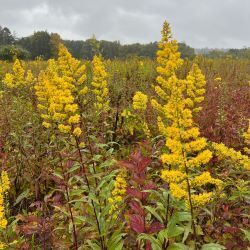 Showy Goldenrod
Showy GoldenrodSolidago speciosa
True to it's common name, this goldenrod's big, yellow inflorescence is 1 ft long and quite showy! The panicle, made up of small yellow compound flowers, sits atop smooth, erect central stems reddish in color.
Height: 2-3ft
Bloom Time: July- September
Sun: Full sun Soil: Medium to Dry
Wildlife Value: attracts honeybees, bumblebees, ants, beetles and the occasional moth or butterflyDEER RESISTANT
LOCAL ECOTYPE*Original ecotype collected in Bedford, NY; seed grown out at Hilltop Hanover Farm.
_____ -
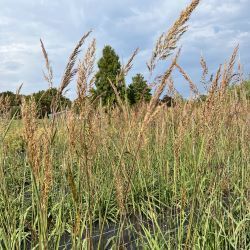 Indian Grass
Indian GrassSorghastrum nutans
A broader leaved grass with delicate yellow flowers that fits well behind and amongst flowers in meadow plantings. Original ecotype collected in Clermont, NY., seed grown out at Hilltop Hanover Farm in Yorktown Heights, NY.
Height: 3-8 feet
Bloom time: August-September
Sun: Full sun
Soil: dry to moist, deep well drained sandy loam
Wildlife value: Larval host plant to pepper-and-salt skipper butterfly. Seeds feed small mammals and birds. Ground cover and nesting site for songbirds and larger birds. Nesting material and structure for native bees.LOCAL ECOTYPE
*Original ecotype collected in Clermont, NY; seed grown out at Hilltop Hanover Farm.
______ -
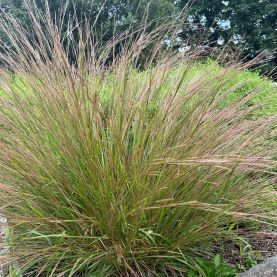 Little Bluestem
Little BluestemSchizachyrium scoparium
Ornamental warm season prairie grass which gets its name from the color of the stem base in spring. It turns a reddish brown color in the fall and forms a stunning display when planted en masse.
Height: 3ft
Bloom time: July-November
Sun: full sun to part shade
Soil: medium to dry, will not tolerate wetlands
Wildlife value: Seeds are eaten by songbirds, host plant to several species of skippersDEER RESISTANT
LOCAL ECOTYPE*Original ecotype collected in Somers, NY; seed grown out at Hilltop Hanover Farm.
_____
